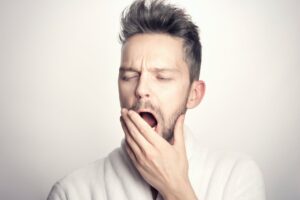Eustachian Tube Dysfunction
 The Eustachian tube is a small canal that connects the middle ear to the back of the nose and upper throat. It is normally closed but opens when we swallow, yawn, or chew.
The Eustachian tube is a small canal that connects the middle ear to the back of the nose and upper throat. It is normally closed but opens when we swallow, yawn, or chew.
Normal functions of the Eustachian tube:
- Ventilation of the middle ear – Helps keep the air pressure equal on either side of the eardrum (i.e., tympanic membrane), enabling the eardrum to work and vibrate correctly.
- Drainage of secretions from the middle ear cleft.
- Protection of the middle ear from pathogens (e.g., bacteria, viruses, fungi)
Dysfunction of the Eustachian tube or Eustachian tube dysfunction (ETD) may occur when the mucosal lining of the tube is swollen or does not open or close appropriately.
Causes:
- 1. Allergic rhinitis (i.e., hay fever) – Seasonal or perennial in nature
- Upper respiratory tract infections (URI’s) – Single or recurrent episodes
- Nasal septal deviation (i.e., deviated septum)
- Cleft palate
- Enlarged adenoids and/or tonsils – Especially in children
- Nasal polyps
Risk Factors:
- Tobacco smoke
- Acid reflux [i.e., gastroesophageal reflux disease (GERD)]
- Radiation exposure
Symptoms:
- Feeling of clogging, fullness or pressure in the ear(s)
- Pain or discomfort in the ear(s)
- Muffled or decreased hearing
- Ringing sensation in the ear(s)
- Dizziness, vertigo, or feeling of imbalance
Complications:
- Otitis media with effusion (i.e., glue ear)
- Middle ear atelectasis (i.e., retraction of the eardrum)
- Chronic otitis media
Diagnosis:
The inability to “clear” or “pop” the ear with changes in barometric pressure, together with other patient-reported symptoms (e.g., aural fullness, pain, muffled hearing) is consistent with Eustachian tube dysfunction.
Tests:
- Otoscopy
- Tympanometry
- Nasal endoscopy
Treatment:
Non-Surgical:
- Supportive care – Includes advice about self-management such as to swallow, yawn, or chew. These measures are especially useful while flying as sudden changes in barometric pressures aggravate Eustachian tube dysfunction.
- Pressure equalization methods – A technique where the Eustachian tube is reopened by raising the pressure in the nose. This can be accomplished by forced exhalation against a closed mouth and nose which is referred to as the Valsalva maneuver. Blowing balloons is also helpful in relieving the pressure in the middle ear by forcing air into the Eustachian tubes and keeping them patent.
- Nasal douching – The nasal cavity is washed with a saline solution in order to flush out excess mucus and debris from the nose and sinuses.
- Decongestants, antihistamines, nasal or oral corticosteroids – These medications are aimed at reducing nasal congestion and/or inflammation of the lining of the Eustachian tube.
- Antibiotics – Used for the treatment of rhinosinusitis (i.e., sinus infections)
- Simethicone – This is currently being investigated in adults to assess whether or not it can help to break up bubbles that may block the opening of the Eustachian tube in the back of the nose during an upper respiratory infection. As a result, air should be able to pass between the nose and middle ear easier.
Surgical:
- Insertion of a pressure equalizing tube into the eardrum – Also known as a tympanostomy tube, ventilation tube, or grommet. Pressure equalizing tubes typically fall out of the ears after 6-9 months.
- Eustachian tuboplasty – Balloon dilatation of the Eustachian tube
Of note: The opposite condition of Eustachian tube dysfunction is called patulous Eustachian tube. In this malady, there is an abnormal patency of the Eustachian tube. Instead of being in the normal closed position, the Eustachian tube stays intermittently open, causing an echoing sound of the person’s own heartbeat, breathing, and/or speech. These sounds will then vibrate directly onto the eardrum causing a “bucket on the head” sound effect. This condition can usually be managed by nasal sprays. Rarely, surgical intervention is warranted.
The board certified allergists at Black & Kletz Allergy has 3 locations in the Washington, Northern Virginia, and Maryland metropolitan area. We have offices in Washington, DC, McLean, VA (Tysons Corner, VA), and Manassas, VA. All 3 of our offices have on-site parking and the Washington, DC and McLean, VA offices are Metro accessible. The McLean office has a complementary shuttle that runs between our office and the Spring Hill metro station on the silver line. The allergy specialists of Black & Kletz Allergy diagnose and treat both adult and pediatric patients. For an appointment, please call our office or alternatively, you can click Request an Appointment and we will respond within 24 hours by the next business day. The allergy specialists at Black & Kletz Allergy have been helping patients with Eustachian tube dysfunction, allergic rhinitis (i.e., hay fever), asthma, sinus disease, eczema (i.e., atopic dermatitis), hives (i.e., urticaria), insect sting allergies, immunological disorders, medication allergies, and food allergies for more than 50 years. If you suffer from allergies, it is our mission to improve your quality of life by reducing or preventing your undesirable and annoying allergy symptoms.
